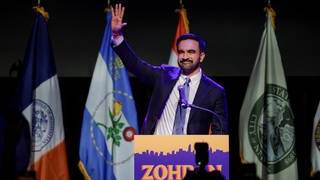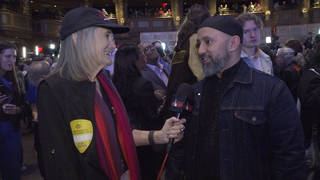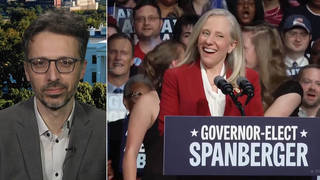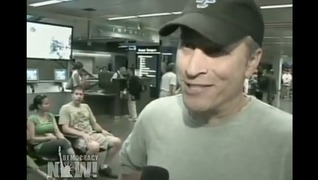
Topics
Guests
- Coleen Rowleyworked as an FBI special agent for almost twenty-four years. In 2002, she was named Time Magazine’s Person of the Year after she blew the whistle on pre-9/11 intelligence failures. She lives just outside Minneapolis.
- Bruce NestorPresident of the Minnesota Chapter of the National Lawyers Guild.
Armed groups of police in the Twin Cities have raided more than half-a-dozen locations since Friday night in a series of “preemptive raids” before the Republican National Convention. The raids and detentions have targeted activists planning to protest the convention, as well as journalists and videographers documenting police actions at protests. [includes rush transcript]
Transcript
AMY GOODMAN:
As we interviewed Jon Stewart at the Minneapolis airport next to baggage claim, we got a text message that Democracy Now! videographer, filmmaker Elizabeth Press, who had arrived before us, had been arrested, or she had been detained, or she was in a house with I-Witness Video, and somehow the group was surrounded by police. That was the last details we had. We had the address of the place; they were texted to us. And we raced off.
Armed groups of police in the Twin Cities have raided more than a half-a-dozen locations since Friday night in a series of preemptive raids before the Republican convention. The coordinated searches were led by Ramsey County Sheriff Bob Fletcher but conducted in coordination with federal agencies.
Five Minnesotan activists are still detained on probable cause holds, which means they can be held for thirty-six hours without charge, excluding weekends and public holidays. According to this timeline, they won’t be released before Wednesday. The sheriff called them “criminal anarchists who are intent on committing criminal acts before and during the Republican National Convention.”
The raids and detentions have targeted activists planning to protest the Republican National Convention, as well as journalists and videographers documenting police actions at protests. Groups directly affected by the raids include Food Not Bombs, the RNC Welcoming Committee, I-Witness Video and Communities United Against Police Brutality.
Democracy Now! spoke to Michelle Gross from Communities United Against Police Brutality on Sunday. She was at the activist convergence space Friday night when it was raided.
MICHELLE GROSS: I was sitting there waiting for a meeting to happen with other legal people. We were working with a kind of a collective of legal people, and we were waiting to have a meeting. And I was literally just sitting there drinking some water and relaxing, when, you know, these Ramsey County Sheriff’s Department people came blazing in, screaming “Get on the floor! Get on the floor!” and waving guns at everybody in their faces.
And they basically — at the time, I quickly thought and opened up my video camera and hit my record button and started recording the scene. Then, because they were, you know, waving guns in my face, of course, I had to hit the floor, but I kept my camera recording the whole time.
AMY GOODMAN:
Gross was held for forty-five minutes, then released. But when she returned home, she found her home and car had been broken into and all her documents thoroughly searched.
Democracy Now!’s Elizabeth Press and I-Witness Video founder Eileen Clancy were among those detained in one of the raids in St. Paul Saturday afternoon. We arrived on the scene soon afterward. Eileen Clancy spoke to us and other reporters from the backyard of the house where she was being held. She was handcuffed with her colleagues.
EILEEN CLANCY: They’ve been detaining people for days around here. And they photographed us. They look through our materials. They copy our materials and don’t return them to you. And then you’re merely detained, so you don’t have the same situation where you have police officers swearing out affidavits, which we could prove was false. This seems to be a new technique.
AMY GOODMAN:
Eileen Clancy was sitting with her hands behind her back, handcuffed, surrounded by St. Paul police, along with her colleagues who had been inside the house. She was shouting to us across the yard. The police had said we had to stay in the front, across the street. But her next — but the next-door neighbor of the house where the activists, the I-Witness videographers, were inside, told us to go through her house, the next-door neighbor, and we could stand in the backyard to speak and witness what was taking place, as the I-Witness videographers were brought into that backyard and were handcuffed.
The National Lawyers Guild and Communities United Against Police Brutality filed an emergency motion Sunday asking Judge Mark Wernick to grant “injunctive relief to prevent police from seizing video equipment and cellular phones used to document their conduct.” The groups sought a temporary restraining order on police to stop them from illegally detaining journalists and confiscating equipment.
I’m joined here in St. Paul at St. Paul Neighborhood Network by Bruce Nestor from the Minnesota chapter of the National Lawyers Guild. We’re also joined by Coleen Rowley. She has worked as an FBI special agent for almost twenty-four years. In 2002, she was named Time Magazine’s Person of the Year after she blew the whistle on pre-9/11 intelligence failures.
We welcome you both to Democracy Now! Let’s begin with you, Bruce Nestor. What is going on here? One raid after another throughout St. Paul? What are these preemptive raids? What does that mean?
BRUCE NESTOR: It was really an effort led by the Ramsey County Sheriff to put people in preventative detention. The raids were carried out by Sheriff Bob Fletcher, who had been arguing for months that there needed to be a stronger law enforcement response, and he was being told that wasn’t necessary. And so, he sent his officers in, after doing intelligence gathering and infiltrating these groups.
And then, really what he did is he took common household items that you would find in any home in Minnesota — a hatchet, rope, glass bottles and rags — attached the label “anarchist” to the people who are living in the homes, and then raise this public fear that the anarchists were threatening violence, public disorder. But really, it’s taking a common household item, something you’d find anywhere, calling it an edged weapon and then attacking people for their political beliefs, that then is used to generate this public fear and keep activists detained, as you said, through Wednesday at noon.
AMY GOODMAN:
This situation that we witnessed in St. Paul, where I-Witness Video was surrounded by police, they moved in on the videographers with a weapon drawn. Democracy Now!’s Elizabeth Press was inside. She was filming. The police came in with their weapon drawn on these videographers.
BRUCE NESTOR: They did the same thing in the house raids in south Minneapolis. They broke down doors, even though these were knock warrants, meaning they were supposed to knock and announce themselves. I was personally present and saw officers with riot gear and assault rifles, pump action shotguns. The neighbor of one of the houses had a gun pointed in her face when she walked out on her back porch to see what was going on. There were children in all of these houses, and children were held at gunpoint. Everyone was forced to the floor and handcuffed and then detained for about an hour, while they were processed out, and then individuals were released.
It was really an overwhelming show of force, again, designed to heighten public fear to do two things: to make people fearful of the protests, but also to discourage people from protesting. I think it’s somehow designed to say, you know, don’t take to the streets, because this could happen to you, or you could get caught up in this, and therefore, don’t get involved. And that’s why they have that level of force involved.
AMY GOODMAN:
Coleen Rowley, you’re a former FBI agent. As I talked to Elizabeth, our producer, here in St. Paul, one of the people who was arrested or detained at I-Witness, it seems that they were careful not to arrest at least this group but detain them for hours. They’re handcuffed. One of the protesters, his arms were red for hours afterwards. But she said that before the police came in, the FBI was there. What is the role of the FBI in this? Who is doing this?
COLEEN ROWLEY: Well, I can tell you what it’s supposed to be. And then I retired in 2004, and so these fusion centers have grown, of course, since that time, and who knows what it actually now amounts to? What it actually is supposed to be is in a major event, such as the RNC, the FBI is really to take the lead on the counterintelligence aspect, which, of course, if there was a true threat — let’s say there was a domestic terrorism group, which is — this is what we’re talking about. We’re talking about at the very most nonviolent civil disobedience. So the confusion with true intelligence for a terrorist threat is quite enormous. There’s a big range there. But in a real case, obviously, if you really did have, let’s say, the Aryan Brotherhood or something like that, a group bent on terrorism, the FBI is supposed to take the lead on that and coordinate the intelligence gathering.
AMY GOODMAN:
What is your experience with preemptive raids?
COLEEN ROWLEY: Well, the word “preemptive,” of course, is —- should send a red flag up, because that word came into play right before the Iraq war. And, of course, we all know that it’s very, very difficult to determine ahead of time what is a true threat. And so, when you start this word “preemptive,” and now, unfortunately, it seems to have migrated to domestic law enforcement. You cannot determine -— we always talk about intent and capability, and if you really know that a group is going to pull off a bank robbery, you really have to make sure that an overt act is committed in furtherance of that. It’s not enough to know, for instance, that somebody’s talking about a bank robbery. So that’s a problem here, and certainly when you get into satire and, you know, taunts and this type of thing, it seems to be a terribly misguided and an overreaction on the part of police.
And it has terrible consequences, actually, for policing, too, which I can talk about later. People put this — they try to say, well, security, we must sacrifice civil liberties. They think of it as a tradeoff. And it is absolutely not true. Our security does depend on good police work. And so, when police do this, and they go against their own community policing model, they actually so distrust, so that if they do want to ask a question of someone next time, let’s say, there is a true threat, somebody may say, “I don’t want to talk to you. I know what happened last week when you handcuffed people incorrectly.” This is just sending a very bad signal to police work. And I’m sure there are many police officers who are just as disappointed with this, because it’s going to make their job in the future much more difficult.
AMY GOODMAN:
As the police were surrounding I-Witness Video and Elizabeth Press, I asked the police officer if it was true that one of them came in earlier with an AR-15, with an automatic weapon, and he said yes.
COLEEN ROWLEY: Yeah, it’s — you know, again, with the escalation of force, and you get to the point where imminent — the word always is “imminent” threat, where you actually are allowed to use deadly force. FBI agents, for instance, train on this standard. All law enforcement trains on this standard. And to see this now erased a little bit is very wrong, and it needs to be corrected.
AMY GOODMAN:
Coleen Rowley, you mentioned fusion centers. Explain what they are?
COLEEN ROWLEY: Well, you know, fusion centers are where law enforcement can combine forces. It has a good aspect, obviously, because you don’t want these jurisdictional restraints sometimes to prevent sharing of information. So there’s a good side to that.
There’s a bad side, potentially a bad side, which is that the separate jurisdictions exist for a reason. So, for instance, Ramsey County, seems like much of this is emanating from Sheriff Fletcher in Ramsey County. He seems to be the one that is into this preemptive show. I would think that St. Paul, the community policing model, is maybe not. But now, when you combine forces, you know, you see that problem of that — they all have the same equal law enforcement, maybe, authority in some of these cases. And Minnesota actually is quite a state that has always looked at separate jurisdictions. So the fusion center could have that problem.
AMY GOODMAN:
Are there infiltrators? Is there surveillance that you know about going on in peaceful protests?
COLEEN ROWLEY: Well, here’s what — you know, our group, we have been at peace vigils now for five, going on six, years, and, you know, we’ve never had this problem that in this last week — our peace vigils in suburbs have been approached by police.
AMY GOODMAN:
What do you mean “approached”?
COLEEN ROWLEY: We’ve had police officers come up to both of our really — we stand at a corner holding a sign, for one place, for over three years. And now we have police checking on intelligence and talking to us about violence. And, of course, we think of this as very intimidating. I have numerous peace folks who have marched for five years, who are now actually worried about not only Monday, but the whole week. Many of our artistic — my group is having a picnic, for instance, on Harriet Island. Now, you can’t imagine something more peaceful than a peace island picnic, and yet people are worried that that could be disrupted by this — a show of force and also by — you know, people are worried and may stay away. So this is very wrong.
It not only hurts civil liberties and the exercise of First Amendment rights, but it actually also hurts security. That’s something to keep in mind. This does not help security. It takes the police away from true threats, and then it also causes later problems for them trying to talk to people and get cooperation from the public.
AMY GOODMAN:
Bruce Nestor, what is this injunction that has been sought?
BRUCE NESTOR: This started out with a raid on Glass Bead Collective, a group here out of New York City that last week was arrested at 1:30 in the morning for walking near some railroad tracks in northeast Minneapolis.
AMY GOODMAN:
Now, explain. Two of them had gone to get their friend who came in on the bus?
BRUCE NESTOR: That’s right. They had gone down to the Greyhound station in downtown Minneapolis, were taking the 17B city bus back to their house, where they were staying, got off the bus, walked two blocks. And it borders a railroad track, as do lots of streets in Minneapolis. The police were quoted as saying, “We’ll arrest anybody” — or “We’ll detain and question anyone walking near railroad tracks at 1:30 in the morning.”
They then explained who they were. They provided identification. They had all of their equipment seized — diaries, computers, video cameras, still cameras, money, personal belongings and clothes — and were held for twenty-four hours, that equipment. We actually got it back through public pressure, going to the media, holding a press conference.
But this is a pattern, and it was a pattern that didn’t get publicity in Minneapolis, particularly people with Communities United Against Police Brutality. And so, part of the affidavits filed with the temporary injunction order that we are seeking included copwatchers, who have had their equipment taken and smashed, memory cards erased, because they’re just documenting police abuse during the course of ordinary arrests.
So we saw an escalation of that once the RNC is in town. The harassment of I-Witness Video is part of that, as well as the questioning of people just taking photographs. A former producer for a local TV station photographed a police SWAT team. He was stopped, questioned. His memory card was erased. Ordinary activity is being treated with this overwhelming level of force, and people are being detained. And so, we tried to get the injunction to say, particularly in terms of people documenting police misconduct, you can’t seize their video cameras, and you can’t erase images. You have to preserve that.
AMY GOODMAN:
Coleen Rowley?
COLEEN ROWLEY: You know, back in 1986, the FBI overreacted and seized our main newspaper Star Tribune’s and our main television station’s cameras, and it was a very unique situation. But back in ’86, William Kunstler came on the scene, filed a lawsuit, and unfortunately, you know, the FBI lost the case, and it actually set a precedent that you cannot seize a news camera. You know, it’s called, I think — I can’t remember the name of the case, but there is a strong precedent that this violates, of course, First Amendment rights, as well as Fourth Amendment rights. So this should be — the lawyers really need to stay on this. People need to read those affidavits. And ultimately, let’s hope we don’t need a Church Committee when this is all over to sort out these kinds of abuses.
AMY GOODMAN:
Well, I want to thank you both very much for being with us. Coleen Rowley is a former FBI agent, well-known as Time’s Person of the Year after September 11th. That’s Time Magazine. And Bruce Nestor with the Minnesota Chapter of National Lawyers Guild.












Media Options